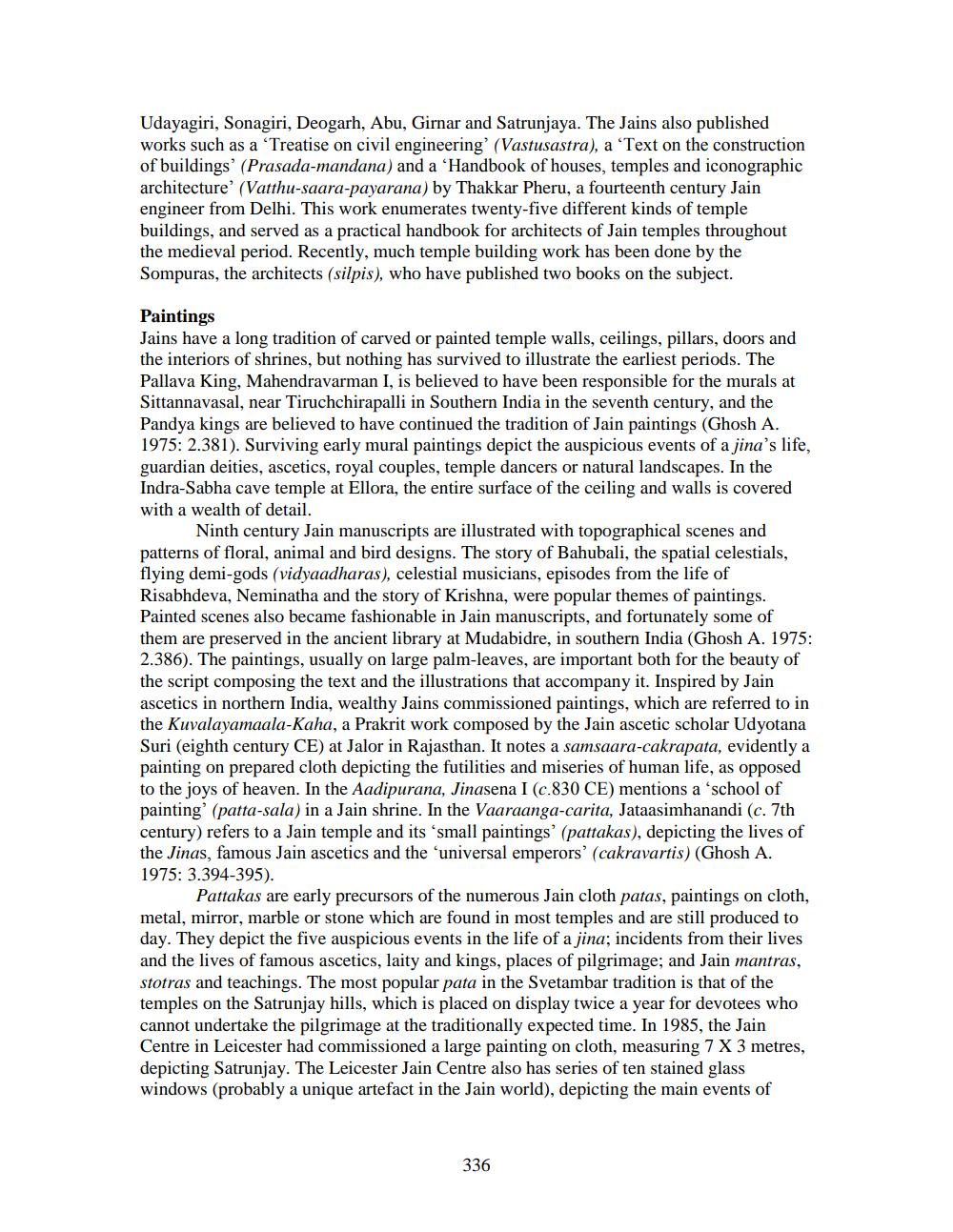________________
Udayagiri, Sonagiri, Deogarh, Abu, Girnar and Satrunjaya. The Jains also published works such as a 'Treatise on civil engineering' (Vastusastra), a 'Text on the construction of buildings' (Prasada-mandana) and a 'Handbook of houses, temples and iconographic architecture' (Vatthu-saara-payarana) by Thakkar Pheru, a fourteenth century Jain engineer from Delhi. This work enumerates twenty-five different kinds of temple buildings, and served as a practical handbook for architects of Jain temples throughout the medieval period. Recently, much temple building work has been done by the Sompuras, the architects (silpis), who have published two books on the subject.
Paintings Jains have a long tradition of carved or painted temple walls, ceilings, pillars, doors and the interiors of shrines, but nothing has survived to illustrate the earliest periods. The Pallava King, Mahendravarman I, is believed to have been responsible for the murals at Sittannavasal, near Tiruchchirapalli in Southern India in the seventh century, and the Pandya kings are believed to have continued the tradition of Jain paintings (Ghosh A. 1975: 2.381). Surviving early mural paintings depict the auspicious events of a jina's life, guardian deities, ascetics, royal couples, temple dancers or natural landscapes. In the Indra-Sabha cave temple at Ellora, the entire surface of the ceiling and walls is covered with a wealth of detail.
Ninth century Jain manuscripts are illustrated with topographical scenes and patterns of floral, animal and bird designs. The story of Bahubali, the spatial celestials, flying demi-gods (vidyaadharas), celestial musicians, episodes from the life of Risabhdeva, Neminatha and the story of Krishna, were popular themes of paintings. Painted scenes also became fashionable in Jain manuscripts, and fortunately some of them are preserved in the ancient library at Mudabidre, in southern India (Ghosh A. 1975: 2.386). The paintings, usually on large palm-leaves, are important both for the beauty of the script composing the text and the illustrations that accompany it. Inspired by Jain ascetics in northern India, wealthy Jains commissioned paintings, which are referred to in the Kuvalayamaala-Kaha, a Prakrit work composed by the Jain ascetic scholar Udyotana Suri (eighth century CE) at Jalor in Rajasthan. It notes a samsaara-cakrapata, evidently a painting on prepared cloth depicting the futilities and miseries of human life, as opposed to the joys of heaven. In the Aadipurana, Jinasena I (c.830 CE) mentions a 'school of painting' (patta-sala) in a Jain shrine. In the Vaaraanga-carita, Jataasimhanandi (c. 7th century) refers to a Jain temple and its small paintings' (pattakas), depicting the lives of the Jinas, famous Jain ascetics and the 'universal emperors' (cakravartis) (Ghosh A. 1975: 3.394-395).
Pattakas are early precursors of the numerous Jain cloth patas, paintings on cloth, metal, mirror, marble or stone which are found in most temples and are still produced to day. They depict the five auspicious events in the life of a jina; incidents from their lives and the lives of famous ascetics, laity and kings, places of pilgrimage; and Jain mantras, stotras and teachings. The most popular pata in the Svetambar tradition is that of the temples on the Satrunjay hills, which is placed on display twice a year for devotees who cannot undertake the pilgrimage at the traditionally expected time. In 1985, the Jain Centre in Leicester had commissioned a large painting on cloth, measuring 7 X 3 metres, depicting Satrunjay. The Leicester Jain Centre also has series of ten stained glass windows (probably a unique artefact in the Jain world), depicting the main events of
336




